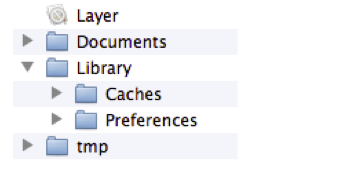深刻講授iOS開辟中運用數據的存儲方法
XmlRss/ target=_blank class=infotextkey>Xml屬性列表-plist
1、運用沙盒
每一個IOS運用都有⾃己的應⽤沙盒(運用沙盒就是文件體系目次),與其他文件體系隔離。應⽤必需待在⾃己的沙盒裡,其他運用不克不及拜訪該沙盒(提醒:在IOS8中曾經開放拜訪)
應⽤沙盒的文件體系⽬錄,以下圖所示(假定運用的稱號叫Layer)

模仿器應⽤用沙盒的根途徑在: (apple是⽤用戶名, 7.0是模仿器版本) /Users/apple/Library/Application Support/iPhone Simulator/7.0/Applications
2、運用沙盒構造剖析
應⽤法式包:(上圖中的Layer)包括了一切的資本文件和可履行文件
Documents:保留應⽤運轉時生成的須要耐久化的數據,iTunes同步裝備時會備份該目次。例如,游戲運用可將游戲存檔保留在該目次
tmp:保留應⽤運轉時所需的暫時數據,使⽤終了後再將響應的文件從該目次刪除。運用沒有運轉時,體系也能夠會消除該目次下的文件。iTunes同步裝備時 不會備份該目次
Library/Caches:保留運用運轉時⽣成的須要耐久化的數據,iTunes同步裝備時不會備份該目次。⼀普通存儲體積年夜、不須要備份的非主要數據
Library/Preference:保留運用的一切偏好設置,IOS的Settings(設置) 應⽤會在該⺫錄中查找應⽤的設相信息。iTunes同步裝備時會備份該目次
3、運用沙盒罕見的獲得方法
沙盒根目次:NSString *home = NSHomeDirectory();
Documents:(2種⽅方法)
應用沙盒根目次拼接”Documents”字符串
NSString *home = NSHomeDirectory();
NSString *documents = [home stringByAppendingPathComponent:@"Documents"]; // 不建議采取,由於新版本的操作體系能夠會修正目次名
應用NSSearchPathForDirectoriesInDomains函數
// NSUserDomainMask 代表從用戶文件夾下找
// YES 代表睜開途徑中的海浪字符“~”
NSArray *array = NSSearchPathForDirectoriesInDomains(NSDocumentDirectory, NSUserDomainMask, NO); // 在iOS中,只要一個目次跟傳入的參數婚配,所以這個聚集外面只要一個元素
NSString *documents = [array objectAtIndex:0];
tmp:NSString *tmp = NSTemporaryDirectory();
Library/Caches:(跟Documents相似的2種⽅辦法)
應用沙盒根目次拼接”Caches”字符串
利⽤NSSearchPathForDirectoriesInDomains函數(將函數的第2個參數改 為:NSCachesDirectory便可)
Library/Preference:經由過程NSUserDefaults類存取該目次下的設相信息
響應的代碼:
#import "NJViewController.h"
#import "NJPerson.h"
@interface NJViewController ()
- (IBAction)saveDataBtnClick:(id)sender;
- (IBAction)readDataBtnClick:(id)sender;
@end
@implementation NJViewController
/**
* 點擊保留按鈕
*/
- (IBAction)saveDataBtnClick:(id)sender {
// youtube做法
// NSString *path = @"/Users/apple/Library/Application Support/iPhone Simulator/7.1/Applications/A6D53E11-DDF0-4392-B2D4-FE77A96888A6/Documents/abc.plist";
// 獲得運用法式根目次
NSString *home = NSHomeDirectory();
// 不建議寫/
//NSString *path = [home stringByAppendingString:@"/Documents"];
// 不建議Documents寫逝世
//NSString *path = [home stringByAppendingPathComponent:@"Documents"];
// NSUserDomainMask 在用戶目次下查找
// YES 代表用戶目次的~
// NSDocumentDirectory 查找Documents文件夾
// 建議應用以下辦法靜態獲得
NSString *doc = [NSSearchPathForDirectoriesInDomains(NSDocumentDirectory, NSUserDomainMask, YES) lastObject];
// 拼接文件途徑
NSString *path = [doc stringByAppendingPathComponent:@"abc.plist"];
NSLog(@"%@", path);
//NSArray *arr = @[@"lnj", @"28"];
//[arr writeToFile:path atomically:YES];
// NSDictionary *dict = @{@"name": @"lnj", @"age":@"28"};
// 挪用writeToFile將數據寫入文件
// [dict writeToFile:path atomically:YES];
/*
plist只能存儲體系自帶的一些慣例的類, 也就是有writeToFile辦法的對象才可使用plist保留數據
字符串/字典/數據/NSNumber/NSData ...
*/
// 自界說的對象不克不及保留到plist中
NJPerson *p = [[NJPerson alloc] init];
p.name =@"lnj";
NSDictionary *dict = @{@"person": @"abc"};
[dict writeToFile:path atomically:YES];
}
/**
* 點擊讀取按鈕
*/
- (IBAction)readDataBtnClick:(id)sender {
NSString *doc = [NSSearchPathForDirectoriesInDomains(NSDocumentDirectory, NSUserDomainMask, YES) lastObject];
NSString *path = [doc stringByAppendingPathComponent:@"abc.plist"]
;
// 讀取數據
NSDictionary *dict = [NSDictionary dictionaryWithContentsOfFile:path];
NSLog(@"%@", dict);
}
@end
4、屬性列表
屬性列表是一種XmlRss/ target=_blank class=infotextkey>Xml格局的文件,拓展名為plist
假如對象是NSString、NSDictionary、NSArray、NSData、 NSNumber等類型,便可以應用writeToFile:atomically:⽅法 直接將對象寫到屬性列表文件中
NSKeydeArchiver歸檔
1、簡略解釋
在應用plist停止數據存儲和讀取,只實用於體系自帶的一些經常使用類型能力用,且必需先獲得途徑絕對費事;
偏好設置(將一切的器械都保留在統一個文件夾上面,且重要用於存儲運用的設相信息)
歸檔:由於前二者都有一個致命的缺點,只能存儲經常使用的類型。歸檔可以完成把自界說的對象寄存在文件中。
2、代碼示例
1.文件構造

//
// YYViewController.m
// 02-歸檔
//
// Created by apple on 14-6-7.
// Copyright (c) 2014年 itcase. All rights reserved.
//
#import "YYViewController.h"
#import "YYPerson.h"
@interface YYViewController ()
- (IBAction)saveBtnOnclick:(id)sender;
- (IBAction)readBtnOnclick:(id)sender;
@end
@implementation YYViewController
- (void)viewDidLoad
{
[super viewDidLoad];
}
- (IBAction)saveBtnOnclick:(id)sender {
//1.創立對象
YYPerson *p=[[YYPerson alloc]init];
p.name=@"文頂頂";
p.age=23;
p.height=1.7;
//2.獲得文件途徑
NSString *docPath=[NSSearchPathForDirectoriesInDomains(NSDocumentDirectory, NSUserDomainMask, YES)lastObject];
NSString *path=[docPath stringByAppendingPathComponent:@"person.yangyang"];
NSLog(@"path=%@",path);
//3.將自界說的對象保留到文件中
[NSKeyedArchiver archiveRootObject:p toFile:path];
}
- (IBAction)readBtnOnclick:(id)sender {
//1.獲得文件途徑
NSString *docPath=[NSSearchPathForDirectoriesInDomains(NSDocumentDirectory, NSUserDomainMask, YES)lastObject];
NSString *path=[docPath stringByAppendingPathComponent:@"person.yangyang"];
NSLog(@"path=%@",path);
//2.從文件中讀取對象
YYPerson *p=[NSKeyedUnarchiver unarchiveObjectWithFile:path];
NSLog(@"%@,%d,%.1f",p.name,p.age,p.height);
}
@end
新建一個person類
YYPerson.h文件
//
// YYPerson.h
// 02-歸檔
//
// Created by apple on 14-6-7.
// Copyright (c) 2014年 itcase. All rights reserved.
//
#import <Foundation/Foundation.h>
// 假如想將一個自界說對象保留到文件中必需完成NSCoding協定
@interface YYPerson : NSObject<NSCoding>
//姓名
@property(nonatomic,copy)NSString *name;
//年紀
@property(nonatomic,assign)int age;
//身高
@property(nonatomic,assign)double height;
@end
YYPerson.m文件
//
// YYPerson.m
// 02-歸檔
//
// Created by apple on 14-6-7.
// Copyright (c) 2014年 itcase. All rights reserved.
//
#import "YYPerson.h"
@implementation YYPerson
// 當將一個自界說對象保留到文件的時刻就會挪用該辦法
// 在該辦法中解釋若何存儲自界說對象的屬性
// 也就說在該辦法中說清晰存儲自界說對象的哪些屬性
-(void)encodeWithCoder:(NSCoder *)aCoder
{
NSLog(@"挪用了encodeWithCoder:辦法");
[aCoder encodeObject:self.name forKey:@"name"];
[aCoder encodeInteger:self.age forKey:@"age"];
[aCoder encodeDouble:self.height forKey:@"height"];
}
// 當從文件中讀取一個對象的時刻就會挪用該辦法
// 在該辦法中解釋若何讀取保留在文件中的對象
// 也就是說在該辦法中說清晰怎樣讀取文件中的對象
-(id)initWithCoder:(NSCoder *)aDecoder
{
NSLog(@"挪用了initWithCoder:辦法");
//留意:在結構辦法中須要先初始化父類的辦法
if (self=[super init]) {
self.name=[aDecoder decodeObjectForKey:@"name"];
self.age=[aDecoder decodeIntegerForKey:@"age"];
self.height=[aDecoder decodeDoubleForKey:@"height"];
}
return self;
}
@end
3.打印後果和兩個主要的毛病提醒
點擊保留按鈕和讀取按鈕,勝利打印成果以下:

關於不完成兩個協定辦法的毛病提醒:
-(void)encodeWithCoder:(NSCoder *)aCoder辦法:

-(id)initWithCoder:(NSCoder *)aDecoder辦法:

3、繼續類中的應用
新建一個先生類,讓這個類繼續自Preson這個類,增長一個別重的屬性。
YYstudent.h文件
//
// YYstudent.h
// 02-歸檔
//
// Created by apple on 14-6-7.
// Copyright (c) 2014年 itcase. All rights reserved.
//
#import "YYPerson.h"
@interface YYstudent : YYPerson
//增長一個別重屬性
@property(nonatomic,assign) double weight;
@end
YYstudent.m文件
//
// YYstudent.m
// 02-歸檔
//
// Created by apple on 14-6-7.
// Copyright (c) 2014年 itcase. All rights reserved.
//
#import "YYstudent.h"
@implementation YYstudent
//在子類中重寫這兩個辦法
- (void)encodeWithCoder:(NSCoder *)aCoder
{
[super encodeWithCoder:aCoder];
NSLog(@"挪用了YYStudent encodeWithCoder");
[aCoder encodeFloat:self.weight forKey:@"weight"];
}
- (id)initWithCoder:(NSCoder *)aDecoder
{
if (self = [super initWithCoder:aDecoder]) {
NSLog(@"挪用了YYstudent initWithCoder");
self.weight = [aDecoder decodeFloatForKey:@"weight"];
}
return self;
}
@end
YYViewController.m文件
//
// YYViewController.m
// 02-歸檔
//
// Created by apple on 14-6-7.
// Copyright (c) 2014年 itcase. All rights reserved.
//
#import "YYViewController.h"
#import "YYPerson.h"
#import "YYstudent.h"
@interface YYViewController ()
- (IBAction)saveBtnOnclick:(id)sender;
- (IBAction)readBtnOnclick:(id)sender;
@end
@implementation YYViewController
- (void)viewDidLoad
{
[super viewDidLoad];
}
- (IBAction)saveBtnOnclick:(id)sender {
//1.創立對象
// YYPerson *p=[[YYPerson alloc]init];
// p.name=@"文頂頂";
// p.age=23;
// p.height=1.7;
YYstudent *s=[[YYstudent alloc]init];
s.name=@"wendingding";
s.age=23;
s.height=1.7;
s.weight=62;
//2.獲得文件途徑
NSString *docPath=[NSSearchPathForDirectoriesInDomains(NSDocumentDirectory, NSUserDomainMask, YES)lastObject];
NSString *path=[docPath stringByAppendingPathComponent:@"person.yangyang"];
NSLog(@"path=%@",path);
//3.將自界說的對象保留到文件中
// [NSKeyedArchiver archiveRootObject:p toFile:path];
[NSKeyedArchiver archiveRootObject:s toFile:path];
}
- (IBAction)readBtnOnclick:(id)sender {
//1.獲得文件途徑
NSString *docPath=[NSSearchPathForDirectoriesInDomains(NSDocumentDirectory, NSUserDomainMask, YES)lastObject];
NSString *path=[docPath stringByAppendingPathComponent:@"person.yangyang"];
NSLog(@"path=%@",path);
//2.從文件中讀取對象
// YYPerson *p=[NSKeyedUnarchiver unarchiveObjectWithFile:path];
// NSLog(@"%@,%d,%.1f",p.name,p.age,p.height);
YYstudent *s=[NSKeyedUnarchiver unarchiveObjectWithFile:path];
NSLog(@"%@,%d,%.1f,%f",s.name,s.age,s.height,s.weight);
}
@end
點擊保留按鈕和讀取按鈕後的打印輸入:

4、主要解釋
1.保留數據進程:
//1.創立對象
YYstudent *s=[[YYstudent alloc]init];
s.name=@"wendingding";
s.age=23;
s.height=1.7;
s.weight=62;
//2.獲得文件途徑
NSString *docPath=[NSSearchPathForDirectoriesInDomains(NSDocumentDirectory, NSUserDomainMask, YES)lastObject];
NSString *path=[docPath stringByAppendingPathComponent:@"person.yangyang"];
NSLog(@"path=%@",path);
//3.將自界說的對象保留到文件中
[NSKeyedArchiver archiveRootObject:s toFile:path];
2.讀取數據進程:
//1.獲得文件途徑
NSString *docPath=[NSSearchPathForDirectoriesInDomains(NSDocumentDirectory, NSUserDomainMask, YES)lastObject];
NSString *path=[docPath stringByAppendingPathComponent:@"person.yangyang"];
//2.從文件中讀取對象
YYstudent *s=[NSKeyedUnarchiver unarchiveObjectWithFile:path];
3.遵照NSCoding協定,並完成該協定中的兩個辦法。
4.假如是繼續,則子類必定要重寫那兩個辦法。由於person的子類在存取的時刻,會去子類中去找挪用的辦法,沒找到那末它就去父類中找,所以最初保留和讀取的時刻新增長的屬性會被疏忽。須要先挪用父類的辦法,先初始化父類的,再初始化子類的。
5.保留數據的文件的後綴名可以隨便定名。
6.經由過程plist保留的數據是直接顯示的,不平安。經由過程歸檔辦法保留的數據在文件中翻開是亂碼的,更平安。
【深刻講授iOS開辟中運用數據的存儲方法】的相關資料介紹到這裡,希望對您有所幫助! 提示:不會對讀者因本文所帶來的任何損失負責。如果您支持就請把本站添加至收藏夾哦!
- 深刻懂得iOS的狀況欄
- 圖文講授若何處理App的iOS 7頂部狀況欄適配成績
- 實例講授iOS中的UIPageViewController翻頁視圖掌握器
- 實例講授iOS中的CATransition轉場動畫應用
- 舉例講授iOS運用開辟中hitTest觸摸事宜的編寫辦法
- 舉例講授設計形式中的原型形式在iOS運用開辟中的感化
- 實例講授iOS運用開辟中UIPickerView轉動選擇欄的用法
- 舉例講授iOS運用開辟中對設計形式中的戰略形式的應用
- 深刻剖析iOS運用中關於圖片緩存的治理和應用
- 深刻解析設計形式中的裝潢器形式在iOS運用開辟中的完成
- 舉例講授Objective-C中@property屬性的用法
- 實例講授設計形式中的敕令形式在iOS App開辟中的應用
- 實例講授若何在iOS運用開辟中應用設計形式中的署理形式
- 深刻解析iOS運用開辟中對設計形式中的橋接形式的應用
- 實例講授iOS運用的設計形式開辟中的Visitor拜訪者形式




